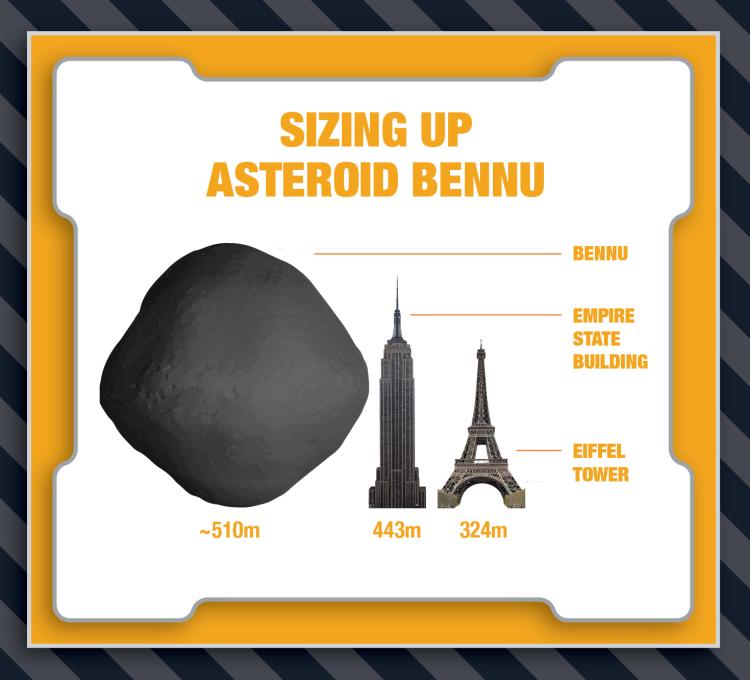
Principal investigator
Daniel ScheeresŐż

Funding
NASA

Collaboration + support
Ann and H.J. Smead Department of Aerospace Engineering Sciences; University of Arizona; NASA Goddard Space Flight Center; Lockheed Martin


 Researchers at CU …ęį…—«÷ř have gotten front-row seats to one of theŐżclosest encounters with an asteroid in history.
Researchers at CU …ęį…—«÷ř have gotten front-row seats to one of theŐżclosest encounters with an asteroid in history.
On Dec. 4, 2018, NASA‚Äôs Origins, Spectral Interpretation, ResourceŐżIdentification, Security-Regolith Explorer (OSIRIS-REx) spacecraftŐżzipped to within 4.5 miles of the asteroid Bennu. This space rock has anŐżorbit that carries it relatively near to Earth about once every six years.
It was the first in a series of planned meet-ups between OSIRIS-RExŐżand Bennu, and good practice for 2020. Next summer, the spacecraftŐżwill dip just above the asteroid‚Äôs surface, using its retractable arm toŐżsnag material from the top and then bring it back to Earth.
CU …ęį…—«÷ř‚Äôs Daniel Scheeres leads the radio science team for OSIRIS-REx.ŐżThe overall mission is led by the University of Arizona. He said it‚ÄôsŐżan unprecedented opportunity to get a zoomed-in look at a class ofŐżmysterious solar system residents.
‚ÄúWhen you‚Äôre going to a new world, you have some idea of what itŐżmight look like,‚ÄĚ said Scheeres, a Distinguished Professor in the AnnŐżand H.J. Smead Department of Aerospace Engineering Sciences. ‚ÄúThenŐżyou actually go there, and you can start comparing what youŐżthought itŐżmight look like versus reality.‚ÄĚ
In particular, his group has an eye on a simple-seeming but importantŐżnumber: Bennu‚Äôs mass.
Scheeres and his colleagues are using OSIRIS-REx‚Äôs navigationalŐżinstruments to measure the minute pull that Bennu exerts on theŐżspacecraft‚ÄĒinformation that then allows them to map out the gravity atŐżits surface.
Scientists want to gather that kind of data for many reasons, saidŐżJay McMahon, an assistant professor in aerospace engineering atŐżCU …ęį…—«÷ř.
Asteroids, for example, provide researchers with a rare window to lookŐżback at the beginnings of the solar system.
‚ÄúOne of the big draws for asteroids is that they‚Äôre leftovers from theŐżformation of the solar system,‚ÄĚ said McMahon, a co-investigator onŐżthe mission. ‚ÄúBennu is a building block of the planets that didn‚Äôt endŐżup in a planet.‚ÄĚ
The results have already started to roll in. In March 2019, theŐżresearchers released their first estimates for the mass of Bennu:Őża respectable 73 billion kilograms.
They‚Äôve also begun to get a closer look at the physics of this body‚ÄĒphysics that would boggle most earthlings.Őż
‚ÄúBennu spins fast enough to create a competition between the gravityŐżthat‚Äôs holding you down and the centrifugal acceleration, which is tryingŐżto throw you off,‚ÄĚ Scheeres said.
And he isn‚Äôt stopping at Bennu, either. In June 2019, NASA picked aŐżmission led by Scheeres, called Janus: Reconnaissance Missions toŐżBinary Asteroids, as a finalist for its SIMPLEx small satellite program.
If the mission gets the final green light, Janus will send twin spacecraftŐżto rendezvous with binary asteroids. Scientists have yet to observe suchŐżobjects, in which two asteroids revolve around each other, up close.
‚ÄúThere are many theories of how binary asteroids form, but we haven‚ÄôtŐżhad the proper measurements to sort through them all and see whichŐżis correct,‚ÄĚ Scheeres said. ‚ÄúThe Janus mission will do this and also helpŐżus better understand how primitive bodies in the solar systemŐżhaveŐżformed and evolved over time.‚ÄĚ
In other words, the solar system‚Äôs asteroids are becoming a little lessŐżpuzzling thanks to CU …ęį…—«÷ř.